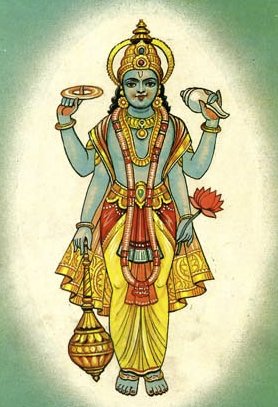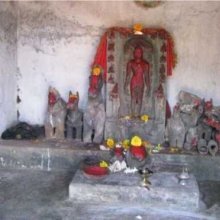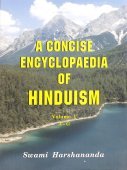Brahmani, Brāhmaṇī, Brahmāṇī: 26 definitions
Introduction:
Brahmani means something in Buddhism, Pali, Hinduism, Sanskrit, the history of ancient India, Marathi, Hindi, biology. If you want to know the exact meaning, history, etymology or English translation of this term then check out the descriptions on this page. Add your comment or reference to a book if you want to contribute to this summary article.
Images (photo gallery)
In Hinduism
Shaktism (Shakta philosophy)
Source: Wisdom Library: ŚāktismBrahmāṇī (ब्रह्माणी):—Name of one of the mātṛs to be worshipped during Āvaraṇapūjā (“Worship of the Circuit of Goddesses”, or “Durgā’s Retinue”), according to the Durgāpūjātattva. They should be worshipped with either the five upācāras or perfume and flowers.
Her mantra is as follows:
Source: Google Books: Manthanabhairavatantramॐ ब्रह्माण्यै नमः
oṃ brahmāṇyai namaḥ.
Brahmāṇī (ब्रह्माणी) is the name of a Mātṛkā (‘mother’) and is identified with the sacred site of Prayāga, according to the Manthānabhairavatantra, a vast sprawling work that belongs to a corpus of Tantric texts concerned with the worship of the goddess Kubjikā.—According to the Kubjikā Tantras, the eight major Kaula sacred sites each have a house occupied by a woman of low caste who is identified with a Mother (Mātṛkā).—[...] Prayāga is identified with (a) the class of prostitute (veśyā) [or sweeper (mātaṅgī)], (b) the Mātṛkā or ‘mother’ named Brahmāṇī, and (c) with the location of ‘navel’.
Source: Google Books: ManthanabhairavatantramBrahmāṇī (ब्रह्माणी) refers to one of the eight Kaula consort (dūtī-aṣṭaka) associated with Avyaktapīṭha (i.e., ‘the unmanifest seat’ representing the act of churning—manthāna), according to the Manthānabhairavatantra, a vast sprawling work that belongs to a corpus of Tantric texts concerned with the worship of the goddess Kubjikā.—[...] The eight Kaula consort (dūtyaṣṭaka): Brahmāṇī, Vaiṣṇavī, Raudrī, Mātaṅgī, Carcikeśvarī, Vārāhī, Nārasiṃhī, Śivādūtī.
Source: Sreenivasarao's blog: Saptamatrka (part 4)Brahmani or Brahmi refers to one of the seven mother-like goddesses (Matrika).—The Matrikas emerge as shaktis from out of the bodies of the gods: Brahmi form Brahma. The order of the Saptamatrka usually begins with Brahmi symbolizing creation. It is often represented by the all-comprehensive primordial Nada Om (pranava). The most important significance of Saptamatrka symbolism is the implication of the cyclical universal time and its cessation. In the standard versions, Brahmi symbolizes creation.

Shakta (शाक्त, śākta) or Shaktism (śāktism) represents a tradition of Hinduism where the Goddess (Devi) is revered and worshipped. Shakta literature includes a range of scriptures, including various Agamas and Tantras, although its roots may be traced back to the Vedas.
Purana and Itihasa (epic history)
Source: Cologne Digital Sanskrit Dictionaries: The Purana IndexBrahmāṇī (ब्रह्माणी).—The image of; four faces and four hands with the swan for riding.*
- * Matsya-purāṇa 261. 24.
Brahmāṇī (ब्रह्माणी) refers to the name of a River mentioned in the Mahābhārata (cf. VI.10.32). Note: The Mahābhārata (mentioning Brahmāṇī) is a Sanskrit epic poem consisting of 100,000 ślokas (metrical verses) and is over 2000 years old.

The Purana (पुराण, purāṇas) refers to Sanskrit literature preserving ancient India’s vast cultural history, including historical legends, religious ceremonies, various arts and sciences. The eighteen mahapuranas total over 400,000 shlokas (metrical couplets) and date to at least several centuries BCE.
Vaishnavism (Vaishava dharma)
Source: Pure Bhakti: Bhajana-rahasya - 2nd EditionBrāhmaṇī (ब्राह्मणी) refers to:—A female brāhmaṇa;the wife of a brāhmaṇa. (cf. Glossary page from Bhajana-Rahasya).

Vaishnava (वैष्णव, vaiṣṇava) or vaishnavism (vaiṣṇavism) represents a tradition of Hinduism worshipping Vishnu as the supreme Lord. Similar to the Shaktism and Shaivism traditions, Vaishnavism also developed as an individual movement, famous for its exposition of the dashavatara (‘ten avatars of Vishnu’).
General definition (in Hinduism)
Source: Wisdom Library: HinduismBrāhmaṇī (ब्राह्मणी) is a Sanskrit word referring to the wife of a Brāhmana.
Source: infoplease: HinduismBrahmani; a woman of the Brahman class.
In Buddhism
Tibetan Buddhism (Vajrayana or tantric Buddhism)
Source: Wisdom Library: Tibetan BuddhismBrahmāṇī (ब्रह्माणी) refers to one of the various Mātṛs and Mahāmātṛs mentioned as attending the teachings in the 6th century Mañjuśrīmūlakalpa: one of the largest Kriyā Tantras devoted to Mañjuśrī (the Bodhisattva of wisdom) representing an encyclopedia of knowledge primarily concerned with ritualistic elements in Buddhism. The teachings in this text originate from Mañjuśrī and were taught to and by Buddha Śākyamuni in the presence of a large audience (including Brahmāṇī).
Source: Google Books: An Esoteric Exposition of the Bardo Thodol Part ABrahmāṇī (ब्रह्माणी):—One of the six Īśvarī performing the rites of pacification.—In the southern direction stands the yellowish-white snake-headed Brahmāṇī who holds a lotus. She embodies the functions of the petal that directs prāṇas to the pancreas, whose secretions represent the physical externalisation of the energies of the Solar Plexus centre, as well as to the Inner Round of small chakras. Being a physical organ the pancreas therefore is a repository of the most Earthy prāṇas from the Watery Solar Plexus centre. The lotus symbolises the attributes of all the small chakras that ascribe to the potency of the vitalisation from the Solar Plexus centre, the central processing organ and directing agent for their prāṇas.
The counterpart of this pair is Manurākṣasī.
Source: academia.edu: The Structure and Meanings of the Heruka Maṇḍala1) Brāhmaṇī (ब्राह्मणी) is the name of a Ḍākinī who, together with the Vīra (hero) named Brāhmaṇa forms one of the 36 pairs situated in the Guṇacakra, according to the 10th century Ḍākārṇava chapter 15. Accordingly, the guṇacakra refers to one of the four divisions of the sahaja-puṭa (‘innate layer’), situated within the padma (lotus) in the middle of the Herukamaṇḍala. The 36 pairs of Ḍākinīs [viz., Brāhmaṇī] and Vīras are whitish red in color; they each have one face and four arms; they hold a skull bowl, a skull staff, a small drum, and a knife.
2) Brāhmaṇī (ब्राह्मणी) is also mentioned as the Ḍākinī of the eastern gate in the Medinīcakra, according to the same work. Accordingly, the medinīcakra refers to one of the three divisions of the dharma-puṭa (‘dharma layer’), situated in the Herukamaṇḍala. The four gate Ḍākinīs [viz., Brahmāṇī] each has the same physical feature as the four Ḍākinīs starting with Lāmā.

Tibetan Buddhism includes schools such as Nyingma, Kadampa, Kagyu and Gelug. Their primary canon of literature is divided in two broad categories: The Kangyur, which consists of Buddha’s words, and the Tengyur, which includes commentaries from various sources. Esotericism and tantra techniques (vajrayāna) are collected indepently.
India history and geography
Source: Project Gutenberg: Castes and Tribes of Southern India, Volume 1Brahmani or Daivampati refers to one of the castes recognised as included in the generic name of Ambalavasi: a generic name applied to all classes of temple servants in Malabar. There are many sub-divisions of the caste (e.g., Brahmani) which are assigned different services in the Hindu temples, such as the preparation of garlands, the sweeping of the floor, the fetching of fire-wood, the carrying of the idols in procession, singing, dancing, and so on.

The history of India traces the identification of countries, villages, towns and other regions of India, as well as mythology, zoology, royal dynasties, rulers, tribes, local festivities and traditions and regional languages. Ancient India enjoyed religious freedom and encourages the path of Dharma, a concept common to Buddhism, Hinduism, and Jainism.
Biology (plants and animals)
Source: Wisdom Library: Local Names of Plants and DrugsBrahmani [ಬ್ರಾಹ್ಮಣಿ] in the Kannada language is the name of a plant identified with Clerodendrum indicum (L.) Kuntze from the Verbenaceae (Verbena) family having the following synonyms: Clerodendrum siphonanthus. For the possible medicinal usage of brahmani, you can check this page for potential sources and references, although be aware that any some or none of the side-effects may not be mentioned here, wether they be harmful or beneficial to health.
Source: Google Books: CRC World Dictionary (Regional names)1) Brahmani in India is the name of a plant defined with Anisomeles malabarica in various botanical sources. This page contains potential references in Ayurveda, modern medicine, and other folk traditions or local practices It has the synonym Ajuga disticha Roxb. (among others).
2) Brahmani is also identified with Clerodendrum indicum It has the synonym Ovieda mitis L. (etc.).
3) Brahmani is also identified with Rotheca serrata It has the synonym Cyclonema serratum Hochst. (etc.).
Example references for further research on medicinal uses or toxicity (see latin names for full list):
· International Journal of Cancer Research (2007)
· Proceedings of the Indian Academy of Sciences (1985)
· Revisio Generum Plantarum (1891)
· Taxon (1982)
· Prodr. (1847)
· Phytologia (1977)
If you are looking for specific details regarding Brahmani, for example pregnancy safety, side effects, health benefits, chemical composition, diet and recipes, extract dosage, have a look at these references.

This sections includes definitions from the five kingdoms of living things: Animals, Plants, Fungi, Protists and Monera. It will include both the official binomial nomenclature (scientific names usually in Latin) as well as regional spellings and variants.
Languages of India and abroad
Marathi-English dictionary
Source: DDSA: The Molesworth Marathi and English Dictionarybrāhmaṇī (ब्राह्मणी).—a Relating to the Brahman.
--- OR ---
brāhmaṇī (ब्राह्मणी).—f (S) A female of the Brahman-caste.
Source: DDSA: The Aryabhusan school dictionary, Marathi-Englishbrāhmaṇī (ब्राह्मणी).—a Relating to the Brahmans. f A female of the brāmhaṇa-caste.
Marathi is an Indo-European language having over 70 million native speakers people in (predominantly) Maharashtra India. Marathi, like many other Indo-Aryan languages, evolved from early forms of Prakrit, which itself is a subset of Sanskrit, one of the most ancient languages of the world.
Sanskrit dictionary
Source: DDSA: The practical Sanskrit-English dictionaryBrahmāṇī (ब्रह्माणी).—
1) The wife of Brahman.
2) An epithet of Durgā.
3) A kind of perfume (= reṇukā).
4) A kind of brass.
--- OR ---
Brāhmaṇī (ब्राह्मणी).—
1) A woman of the Brāhmaṇa caste.
2) The wife of a Brāhmaṇa.
3) Intellect; (buddhi according to nīlakaṇṭha).
4) A kind of lizard; हृष्टः पश्यति तस्यान्तं ब्राह्मणी करकादिव (hṛṣṭaḥ paśyati tasyāntaṃ brāhmaṇī karakādiva) Rām.3.29.5.
5) A kind of wasp.
6) A kind of brass (Mar. sonapitaḷa).
Source: Cologne Digital Sanskrit Dictionaries: Shabda-Sagara Sanskrit-English DictionaryBrahmāṇī (ब्रह्माणी).—f. (-ṇī) 1. The female energy of Brahma. 2. A sort of perfume, commonly Renuka. 3. A kind of brass; “veṅāpitala” . E. brahman Brahma, fem. aff. ṅīp.
Source: Cologne Digital Sanskrit Dictionaries: Cappeller Sanskrit-English DictionaryBrahmāṇī (ब्रह्माणी).—[feminine] Brahman's wife, [Epithet] of Durgā.
--- OR ---
Brāhmaṇī (ब्राह्मणी).—1. v. 1 brāhmaṇa.
--- OR ---
Brāhmaṇī (ब्राह्मणी).—2. [with] bhū become a Brahman.
Source: Cologne Digital Sanskrit Dictionaries: Monier-Williams Sanskrit-English Dictionary1) Brahmāṇī (ब्रह्माणी):—[from brahman] f. the Śakti or personified female energy of Brahmā, the wife of Br°, [Purāṇa] (cf. [Indian Wisdom, by Sir M. Monier-Williams 522])
2) [v.s. ...] Name of Durgā, [Harivaṃśa; DevīP.] ([wrong reading] brāhmānī or brāhmaṇī)
3) [v.s. ...] a kind of perfume, [cf. Lexicographers, esp. such as amarasiṃha, halāyudha, hemacandra, etc.]
4) [v.s. ...] a kind of brass, [cf. Lexicographers, esp. such as amarasiṃha, halāyudha, hemacandra, etc.]
5) [v.s. ...] Name of a river, [Mahābhārata] ([varia lectio] brāhmaṇī).
6) Brāhmaṇī (ब्राह्मणी):—[from brāhmaṇa > brahman] a f. See brāhmaṇī
7) Brāhmaṇi (ब्राह्मणि):—[from brahman] in [compound] for ṇī.
8) Brāhmaṇī (ब्राह्मणी):—[from brahman] b f. (of ṇa) a Brāhmaṇī woman or a Brāhman’s wife, [Kāṭhaka; Gṛhya-sūtra and śrauta-sūtra; Mahābhārata] etc. (ifc. ṇīka cf. sa-brāhmaṇika)
9) [v.s. ...] a kind of lizard with a red tail, [Rāmāyaṇa [Scholiast or Commentator]] (cf. brāhmaṇikā)
10) [v.s. ...] a kind of large-headed ant, [cf. Lexicographers, esp. such as amarasiṃha, halāyudha, hemacandra, etc.]
11) [v.s. ...] a kind of wasp, [cf. Lexicographers, esp. such as amarasiṃha, halāyudha, hemacandra, etc.]
12) [v.s. ...] Clerodendrum Siphonantus, [cf. Lexicographers, esp. such as amarasiṃha, halāyudha, hemacandra, etc.]
13) [v.s. ...] Trigonella Corniculata, [cf. Lexicographers, esp. such as amarasiṃha, halāyudha, hemacandra, etc.]
14) [v.s. ...] Ruta Graveolens, [cf. Lexicographers, esp. such as amarasiṃha, halāyudha, hemacandra, etc.]
15) [v.s. ...] a kind of brass, [cf. Lexicographers, esp. such as amarasiṃha, halāyudha, hemacandra, etc.]
16) [v.s. ...] = buddhi, [Nīlakaṇṭha]
17) [v.s. ...] Name of a river, [Mahābhārata]
18) [v.s. ...] [wrong reading] for brahmāṇī.
19) Brāhmāṇī (ब्राह्माणी):—[from brahman] [wrong reading] for brahmāṇī q.v.
Source: Cologne Digital Sanskrit Dictionaries: Yates Sanskrit-English DictionaryBrahmāṇī (ब्रह्माणी):—[brahmā+ṇī] (ṇī) 3. f. The female energy of Brahmā; a kind of perfume.
[Sanskrit to German]
Sanskrit, also spelled संस्कृतम् (saṃskṛtam), is an ancient language of India commonly seen as the grandmother of the Indo-European language family (even English!). Closely allied with Prakrit and Pali, Sanskrit is more exhaustive in both grammar and terms and has the most extensive collection of literature in the world, greatly surpassing its sister-languages Greek and Latin.
Hindi dictionary
Source: DDSA: A practical Hindi-English dictionaryBrāhmaṇī (ब्राह्मणी):—(nf) the wife of a Brahman.
...
Kannada-English dictionary
Source: Alar: Kannada-English corpusBrahmāṇi (ಬ್ರಹ್ಮಾಣಿ):—[noun] Sarasvati, the wife of Brahma and the Goddess of speech.
--- OR ---
Brāhmaṇi (ಬ್ರಾಹ್ಮಣಿ):—
1) [noun] a woman belonging to brāhmaṇa classe.
2) [noun] the wife of a brāhmaṇa.
3) [noun] Sarasvati, the wife of Brahma.
4) [noun] the intellectual faculty.
5) [noun] the plant Clerodendrum indicum ( = Siphonanthus indica) of Verbenaceae family.
6) [noun] a yellowish metal that is essentially an alloy of copper and zinc; brass.
7) [noun] a kind of lizard with a red tail.
8) [noun] a kind of wasp.
Kannada is a Dravidian language (as opposed to the Indo-European language family) mainly spoken in the southwestern region of India.
See also (Relevant definitions)
Starts with (+10): Brahmani shanti, Brahmanibhu, Brahmanibruva, Brahmaniceli, Brahmanida, Brahmanidhi, Brahmanigamin, Brahmanigotra, Brahmanihata, Brahmanika, Brahmanikalpa, Brahmanike, Brahmanimantanika, Brahmanimantra, Brahmanimata, Brahmanimmita, Brahmanippattu, Brahmanirnaya, Brahmanirukta, Brahmanirupa.
Ends with: Abrahmani.
Full-text (+117): Brahmanitva, Brahmanigamin, Apishala, Hamsagamini, Brahmana, Brahmanika, Brahmanimata, Brahmanacandala, Brahmaniceli, Brahmanirupa, Brahmanihata, Brahmanikalpa, Brahmanigotra, Brahmanitama, Brahmanitara, Brahmanibruva, Brahmaniti, Brahmanisattama, Brahmanimantra, Abrahmani.
Relevant text
Search found 73 books and stories containing Brahmani, Brāhmaṇī, Brahmāṇī, Brāhmaṇi, Brāhmāṇī, Brahmāṇi; (plurals include: Brahmanis, Brāhmaṇīs, Brahmāṇīs, Brāhmaṇis, Brāhmāṇīs, Brahmāṇis). You can also click to the full overview containing English textual excerpts. Below are direct links for the most relevant articles:
Manusmriti with the Commentary of Medhatithi (by Ganganatha Jha)
Verse 9.198 < [Section XXV - Strīdhana (property of the wife)]
Verse 11.138 < [Section XV - Expiation for the killing of Cats and other Animals]
Verse 8.376 < [Section XLVI - Adultery]
The Markandeya Purana (Study) (by Chandamita Bhattacharya)
5. Origin of Caṇḍikā Śakti < [Chapter 3]
Varahi Tantra (English Study) (by Roberta Pamio)
Chapter 29 - The worship of Caṇḍikā < [Summary of the Vārāhī Tantra]
Chapter 31 - The worship of Śaktis < [Summary of the Vārāhī Tantra]
The Practice Manual of Noble Tārā Kurukullā (by Dharmachakra Translation Committee)
Garga Samhita (English) (by Danavir Goswami)
Verse 4.9.7 < [Chapter 9 - The Glories of Srī Ekādaśī]
Verses 4.21.14-15 < [Chapter 21 - Lord Krsna Extinguishes the Forest Fire and Reveals Himself to the Brāhmana’s Wives]
Rig Veda (translation and commentary) (by H. H. Wilson)
Related products



